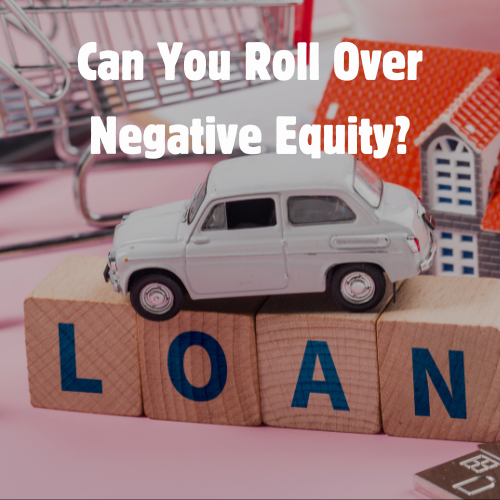When it comes to auto loans and vehicle loans, many people wonder how much negative equity they can roll over into a loan. Negative equity occurs when you owe more on your vehicle than it’s worth. This can happen if your car depreciates faster than you’re paying it off. For those who need to finance a new or used vehicle, understanding how negative equity works in car loans is crucial. TFC Title Loans can help you navigate this process and get you the most money at the lowest interest rates, whether you’re dealing with negative equity or not. All of our referral lenders hold the necessary state-required licenses to ensure a smooth transaction. Additionally, we offer vehicle title loans with credit checks, and we are here to provide a wide range of vehicle types for title loans, such as motorcycles, RVs, and commercial vehicles.
Understanding Negative Equity and Negative Equity Car Loans
Before diving into how much negative equity you can roll over into your auto loan, it’s important to understand what negative equity means. In simple terms, negative equity happens when the amount you owe on your car loan is higher than the market value of your car. This situation occurs when your auto loan exceeds the current market value of your vehicle. If you find yourself in this situation, rolling over your negative equity into a new loan might be an option. This is often referred to as a negative equity car loan.
The amount of negative equity you can roll over depends on the lender’s policies and the value of your vehicle. Generally, lenders allow you to roll over some or all of your negative equity into your new loan. However, rolling over too much negative equity can result in higher monthly payments or longer loan terms. It’s crucial to assess your financial situation before deciding to roll over negative equity.
Calculating Negative Equity
Calculating negative equity is a straightforward process that requires knowing the estimated value of your car and the amount owed on the loan. Here’s a step-by-step guide to help you calculate negative equity:
- Determine the estimated value of your car: Use third-party automotive websites like Kelley Blue Book, Edmunds, or NADAguides to estimate your car’s trade-in value. These platforms provide a reliable estimate based on your car’s make, model, year, mileage, and condition.
- Check the loan payoff amount: Contact your lender to find out the current payoff amount, which includes any interest and fees owed. This is the total amount you need to pay to clear your existing car loan.
- Calculate the negative equity: Subtract the estimated value of your car from the loan payoff amount. If the result is a negative number, you have negative equity.
For example, let’s say your car’s estimated value is $15,000, and the loan payoff amount is $20,000. In this case, the negative equity would be $5,000 ($20,000 – $15,000). Understanding this calculation is crucial when considering your options for a new car loan or trade-in.
How Negative Equity Affects Your Monthly Payment and Loan Terms
When you roll over negative equity, it impacts the loan terms. Lenders may offer you a larger loan amount to cover the balance you owe on your current vehicle and the new vehicle. However, this can lead to higher interest rates and monthly payments, as the lender is taking on additional risk by financing a vehicle worth less than the loan balance. A substantial down payment can help mitigate some of these risks by reducing the loan amount. It’s important to ask your lender about all the details, such as interest rates, loan terms, and fees before agreeing to a loan with negative equity rolled in. Timely loan payments are crucial to avoid further negative equity and potential damage to your credit score.
How Much Negative Equity Can You Roll Over?
The amount of negative equity that can be rolled over into a new car loan varies depending on the lender and the loan terms. Typically, lenders allow a maximum of 125% of the car’s actual worth to be rolled over into a new loan. However, this can lead to a larger debt and higher interest rates.
For instance, if the car’s actual worth is $20,000, the maximum negative equity that can be rolled over would be $25,000 (125% of $20,000). While this might seem like a convenient solution, it’s important to remember that borrowing more than the car is worth can lead to financial difficulties. Higher loan amounts often come with increased interest rates and longer loan terms, which can significantly impact your monthly payments and overall financial health.
What Types of Vehicles Can Be Used for Title Loans in Your Area?
One of the great benefits of title loans is that they can be applied to various types of vehicles. Whether you’re using a motorcycle, RV, classic car, or even a commercial vehicle, title loans can be tailored to suit your needs. TFC Title Loans is here to help you leverage your vehicle’s equity for a loan, with quick approval and a streamlined process. This flexibility can be especially helpful if you have a specialized vehicle or a classic car.
If you’re in need of funds and are worried about your vehicle’s negative equity, don’t worry. You can still use your car, truck, or motorcycle to secure a title loan. With an online title loan process, you could get the funds you need in as little as 24 hours.
Why TFC Title Loans Stands Out in the Industry
As a title loan broker, TFC Title Loans is committed to finding you the best possible deal. Our online process is quick and efficient, allowing you to complete the necessary paperwork without stepping foot into a lender’s office. With the help of our referral lenders, who all hold the state-required licenses, you can rest assured you’re getting the best service possible.
Whether you need a motorcycle title loan, an RV loan, or a commercial vehicle title loan, we provide options for all kinds of vehicles. By rolling over negative equity into your loan, you can potentially reduce your monthly payments and keep your financial situation in check. A car dealer may offer to pay off the remaining balance on your old car loan, but often rolls over the negative equity into a new car loan, which TFC Title Loans can help you manage effectively.
What Is a Pink Slip Title Loan and How Does It Work?
A pink slip title loan is another option available for those looking to secure a loan using their vehicle’s title. The pink slip, also known as a vehicle title, serves as collateral for the loan. Just like other vehicle title loans, pink slip loans allow you to borrow a certain percentage of your vehicle’s value. If you’re rolling over negative equity, your loan amount could be adjusted based on the value of your vehicle and how much equity you have in it.
Factors to Consider When Rolling Over Negative Equity Into a Title Loan
If you’re thinking about rolling over negative equity into a vehicle title loan, it’s essential to consider several factors:
- Loan Amount: Ensure that the loan covers the balance of your existing loan, the new vehicle, and any additional fees.
- Interest Rates: With negative equity, lenders may charge higher interest rates to mitigate their risk.
- Loan Term: Depending on the amount of negative equity, your loan term could be extended, which may impact your monthly payments.
- Vehicle Value: The more valuable your vehicle, the more negative equity you may be able to roll over.
Consulting with a financial advisor or loan expert from TFC Title Loans can help you determine the best course of action when dealing with negative equity. Rolling over negative equity into your next car loan can lead to higher interest rates and increased debt, so it’s important to carefully consider this option.
Alternatives to Rolling Over Negative Equity
Rolling over negative equity into a new car loan is not always the best option. Here are some alternatives to consider:
- Pay off the negative equity: If possible, pay off the negative equity before trading in your car. This will give you a clean start with a new car’s financing deal and can help you avoid higher interest rates and extended loan terms.
- Trade-in with an inexpensive car: Trading in a car with negative equity for an inexpensive car can help you get rid of the negative equity and start fresh with a new car’s financing deal. This approach can be particularly useful if you’re looking to reduce your overall debt.
- Get a personal loan: If you don’t have the cash to pay off the negative equity, consider getting a personal loan with a lower interest rate than your car loan. This can help you pay off the negative equity without rolling it into a new car loan.
- Delay the trade-in: If you can wait, delay the trade-in until the negative equity is paid off. This will save you from rolling over the negative equity into a new loan and can help you secure better loan terms for your next car.
By exploring these alternatives, you can make a more informed decision and potentially avoid the pitfalls of rolling over negative equity into a new car loan.
Managing Negative Equity in a Car Loan
Managing negative equity in a car loan requires careful consideration and planning. Here are some tips to help you manage negative equity:
- Make extra payments: Making extra payments towards the principal can help reduce the loan balance and negative equity. Even small additional payments can make a significant difference over time.
- Refinance the loan: Refinancing the loan with a lower interest rate or a longer loan term can help reduce the monthly payments and negative equity. This can be a viable option if you qualify for better loan terms than your current car loan.
- Sell the car privately: Selling the car privately can help you get a better price for the car and reduce the negative equity. Private sales often yield higher returns compared to trade-ins at a dealership.
- Consider a lease: Leasing a car can help you avoid negative equity, as you’re only paying for the car’s depreciation during the lease term. This can be a good option if you prefer driving a new car every few years without the long-term financial commitment of ownership.
By understanding how to calculate negative equity, knowing how much negative equity can be rolled over, and exploring alternatives to rolling over negative equity, you can make informed decisions when managing negative equity in a car loan. Taking proactive steps can help you maintain better control over your finances and avoid potential pitfalls.
How Long Does It Take to Get the Money?
One of the major advantages of vehicle title loans is the speed of the process. Once you’ve completed your application, including a credit check, the online process will often allow you to receive the funds you need within 24 hours. This fast approval can be helpful in situations where you need money quickly, such as for medical bills, home repairs, or other emergencies.
FAQs
1. Can I get a title loan with negative equity?Yes, it is possible to roll over negative equity into a title loan, but keep in mind that it will affect your loan terms, including the loan amount, interest rate, and repayment period. Achieving positive equity in your vehicle can make it easier to trade in and secure better loan terms.
2. What types of vehicles can I use for a title loan?TFC Title Loans accepts all types of vehicles, including motorcycles, RVs, classic cars, and commercial vehicles.
3. How does a credit check impact my application?All title loan applications undergo a credit check to determine your eligibility for the loan. However, even with poor credit, you may still be able to secure a title loan.
4. How much money can I get with a title loan?The amount you can borrow depends on the value of your vehicle, as well as the lender’s policies and your loan terms.
5. What happens if I can’t repay my title loan?If you’re unable to repay the loan, the lender may repossess your vehicle. It’s important to understand the terms and conditions of your loan agreement to avoid this scenario.
Expert Opinion
Daniel Joelson, a consumer finance expert, explains, “Rolling over negative equity into a vehicle loan can be an option for some borrowers, but it’s important to fully understand the consequences. It’s always recommended to consult with a professional to determine if this is the right choice for your financial situation.”
Conclusion
Understanding how much negative equity you can roll over into a vehicle loan is important for making informed decisions about financing options. At TFC Title Loans, we work with trusted lenders to help you get the most money at the lowest interest rate. Whether you need a loan for a motorcycle, commercial vehicle, or RV, our referral lenders are here to assist you every step of the way. With our fast, 24-hour approval process and a variety of vehicle types eligible for loans, we’re committed to helping you get the funds you need.


